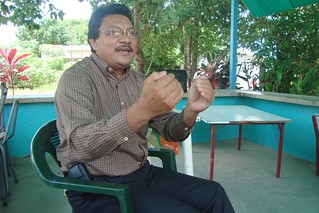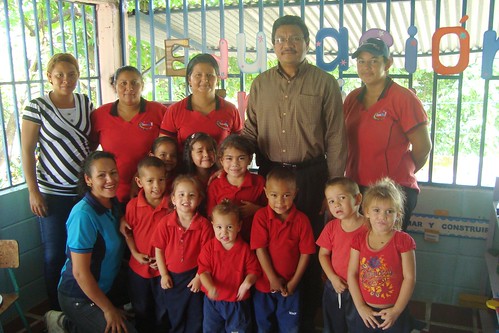Every day we open the preschool with
the raising of the Venezuelan flag and the singing of the national
anthem, followed by a Scripture reading, the Lord's Prayer and a
couple of songs. One song goes like this:
El amor de Dios es maravilloso,
El amor de Dios es maravilloso,
El amor de Dios es maravilloso,
¡Cuan grande es el amor de Dios!
Es tan alto que no puedo ir arriba de él,
Tan profundo que no puedo ir abajo de él,
Tan ancho que no puedo ir afuera de él,
¡Cuan grande es el amor de Dios!
This is based, more or less, on Romans
8:39, “Nor height, nor depth, nor any other creature, shall be able
to separate us from the love of God, which is in Christ Jesus our
Lord.” There are movements to accompany the words of the song. For
example, when you sing, “It's so high that I cannot rise above it,”
you lift your hands up as high as you can. You lower your hands as
far as you can for “It's so deep that I cannot sink beneath it,”
and spread them as far as you can for “It{ s so wide that I cannot
go outside of it.”
 Luz Maria sang this song to her
one-year-old granddaughter, Anyi, when Anyi was lying in a hospital
bed with dengue fever. Despite the fact that dengue fever causes
severe pain in the joints, Anyi began raising and lowering her hands
in response to the song!
Luz Maria sang this song to her
one-year-old granddaughter, Anyi, when Anyi was lying in a hospital
bed with dengue fever. Despite the fact that dengue fever causes
severe pain in the joints, Anyi began raising and lowering her hands
in response to the song!
Rote learning may have a bad name in
certain circles, but incidents like this illustrate its value. I am
glad that a times of stress in my own life that I have not had to
struggle to remember the creeds, the Lord's Prayer, key Bible verses
and hymns. This I credit to the liturgical form of worship that we
followed as a church (which was found in the 1941 Lutheran Hymnal for
the first 20 years of my life).
For Sunday morning worship in La
Caramuca, we follow the liturgy in Culto Cristiano, a
Spanish-language hymnal first published by Concordia Publishing House
in 1964. There has been no complete Spanish-language Lutheran hymnal
published since then. Actually, many in the congregation, both
children and adults, either cannot read at all or are semi-literate.
However, the structure of the liturgy has enabled them to memorize
the creeds, the Lord's Prayer, various hymns and the numerous Bible
verses that are used in the liturgy.
Our place of worship is only a roofed
patio (we hope that soon we might build a real chapel). Our altar is
only a white plastic lawn table. Nevertheless we decorate the altar
in the appropriate liturgical colors, which also are reflected in the
altar candles and my vestments. The liturgical colors are a visual
aid to help everyone recall important events memorialized in the
church calendar and to remind them that we are, in fact, marking
time. We are counting down the days until the Lord's return.
A gentleman named J.A.O. Stubb once
wrote of his early experiences in a Swedish-American Lutheran church:
“As grandfather turned to the Altar and intoned the Lord’s Prayer
and the words of consecration, with the elevation of the
host and the chalice, I felt as if God was near. The congregation
standing reverentially about those kneeling before the Altar, made me
think of Him who, though unseen, was in our midst. I forgot the old,
cold church with its bare walls, its home-made pews and its plain
glass windows. I early came to know some words of that service, such
as: “This is the true body, the true blood of Christ”;
“Forgiveness of sins”; “Eternal life.” I venture that all
who, like me, early received such impressions of the Lord’s Supper,
will approach the Altar or the Communion with a reverence that time
will but slowly efface.” (J.A.O. Stubb, D.D., “Vestments andLiturgies”, 1920).
Of course, the Lutheran liturgy is not
the invention of Swedish-Americans, nor of German-Americans, nor of
any national/ethnic group, but rather is derived from pre-Tridentine
versions of the Latin Mass (when people today speak of “the
traditional Latin Mass”, usually they are thinking of the
Tridentine Mass. This was developed at the Council of Trent
(1545-1563) and adopted as the standard order of worship by the Roman
Catholic Church in 1570 (it would later be replaced as the norm by
the post-Vatican II Novo Ordo in 1969).The Tridentine Mass was
developed some time after the first specifically Lutheran form of the
Latin Mass in 1523. As the Lutheran order of worship retained all the
elements of the Mass except those that directly contradicted the
principles of “Scripture alone, faith alone and grace alone,” the
Tridentine Mass by design reflected the Council of Trent s rejection
of those principles.
Nearly all Lutheran churches throughout
the world use some form of the revised “Western rite”, translated
into vernacular languages. One exception being the Ukrainian
Lutheran Church, which subscribes to the Book of Concord, but uses an
order of worship based on Byzantine (Greek Orthodox) liturgies. All
variations of the Lutheran liturgy draw on the liturgical heritage of
the ancient church (and beyond, since the worship of the early church
was rooted in the liturgical worship of the Temple and the
synagogues) as the most appropriate manner of conducting the ministry
of the Word and the sacraments.
Christmas in June
 Here in La Caramuca we got some
presents early, as we were visited by a delegation from our national
church, the Lutheran Church of Venezuela. The delegation included
Pastor Elias Lozano, the newly elected president of the ILV; Pastor
Miguelangel Perez, vice president of the ILV; and Pastor Abel Garcia,
director of the Juan de Frias Theological Institute. They gave us
some Spanish Bibles with Luther's Small Catechism included as an
appendix. We hope to present them to our next group of confirmands.
Here in La Caramuca we got some
presents early, as we were visited by a delegation from our national
church, the Lutheran Church of Venezuela. The delegation included
Pastor Elias Lozano, the newly elected president of the ILV; Pastor
Miguelangel Perez, vice president of the ILV; and Pastor Abel Garcia,
director of the Juan de Frias Theological Institute. They gave us
some Spanish Bibles with Luther's Small Catechism included as an
appendix. We hope to present them to our next group of confirmands.
These Bibles represent part of the work
of the Lutheran Heritage Foundation, an organization that has has
published the catechism in more than 50 languages, and published and
distributed more than 450 titles and 3 million Lutheran books to
pastors, seminary students, missionaries and churches. The Bible
translation used is the 1960 revision of the Reina-Valera Bible. This
is our preferred translation. There are more contemporary Spanish
translations, and I know the argument that contemporary translations
based on earlier manuscripts should be better than the translations
of the Reformation era based on the Textus Receptus (the
Reina-Valera, King James Version and Luther's German Bible).
Unfortunately, most contemporary translations either reflect more of
the theological and political prejudices of the translators or fail
to convey the meaning of the original text as powerfully as the older
translations.




No comments:
Post a Comment